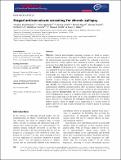Staged anticonvulsant screening for chronic epilepsy

View/
Author
Berdichevsky, Yevgeny
Saponjian, Yero
Park, Kyung‐Il
Roach, Bonnie
Pouliot, Wendy
Lu, Kimberly
Swiercz, Waldemar
Dudek, F. Edward
Published Version
https://doi.org/10.1002/acn3.364Metadata
Show full item recordCitation
Berdichevsky, Yevgeny, Yero Saponjian, Kyung‐Il Park, Bonnie Roach, Wendy Pouliot, Kimberly Lu, Waldemar Swiercz, F. Edward Dudek, and Kevin J. Staley. 2016. “Staged anticonvulsant screening for chronic epilepsy.” Annals of Clinical and Translational Neurology 3 (12): 908-923. doi:10.1002/acn3.364. http://dx.doi.org/10.1002/acn3.364.Abstract
Abstract Objective: Current anticonvulsant screening programs are based on seizures evoked in normal animals. One‐third of epileptic patients do not respond to the anticonvulsants discovered with these models. We evaluated a tiered program based on chronic epilepsy and spontaneous seizures, with compounds advancing from high‐throughput in vitro models to low‐throughput in vivo models. Methods: Epileptogenesis in organotypic hippocampal slice cultures was quantified by lactate production and lactate dehydrogenase release into culture media as rapid assays for seizure‐like activity and cell death, respectively. Compounds that reduced these biochemical measures were retested with in vitro electrophysiological confirmation (i.e., second stage). The third stage involved crossover testing in the kainate model of chronic epilepsy, with blinded analysis of spontaneous seizures after continuous electrographic recordings. Results: We screened 407 compound‐concentration combinations. The cyclooxygenase inhibitor, celecoxib, had no effect on seizures evoked in normal brain tissue but demonstrated robust antiseizure activity in all tested models of chronic epilepsy. Interpretation The use of organotypic hippocampal cultures, where epileptogenesis occurs on a compressed time scale, and where seizure‐like activity and seizure‐induced cell death can be easily quantified with biomarker assays, allowed us to circumvent the throughput limitations of in vivo chronic epilepsy models. Ability to rapidly screen compounds in a chronic model of epilepsy allowed us to find an anticonvulsant that would be missed by screening in acute models.Other Sources
http://www.ncbi.nlm.nih.gov/pmc/articles/PMC5224819/pdf/Terms of Use
This article is made available under the terms and conditions applicable to Other Posted Material, as set forth at http://nrs.harvard.edu/urn-3:HUL.InstRepos:dash.current.terms-of-use#LAACitable link to this page
http://nrs.harvard.edu/urn-3:HUL.InstRepos:30371039
Collections
- HMS Scholarly Articles [17922]
Contact administrator regarding this item (to report mistakes or request changes)


